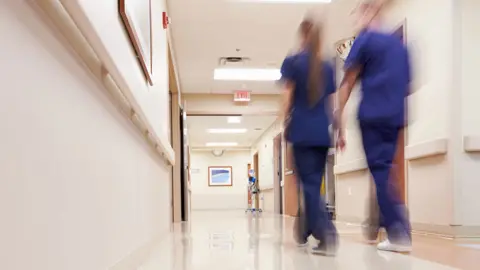A&E: Longest waiting times hit a new record in Wales
 monkeybusinessimages/Getty Images
monkeybusinessimages/Getty ImagesThe number of patients spending more than 12 hours in A&E in Wales was the highest on record again in January.
Altogether, 6,882 patients faced long waits, 226 more than in December. No patient should be waiting that long.
Opposition parties called the figures "unacceptable" and a "scandal" while the Welsh Government said it expected improvements.
However, ambulance response times improved and hit their target for the first time since October.
Latest official figures for January show 66% of the most serious "red" calls arriving within eight minutes, meeting the target for the first time since October.
As in England, there was also an improvement in performance against the four-hour A&E waiting time.
The proportion of patients waiting in A&E for less than four hours to be treated, transferred and discharged was 74.6%. This compares to a record low of 72.1% in December.
The figures also show:
- 83.5% of patients were waiting less than six months to start hospital treatment - the lowest proportion since December 2015 and lower than the 95% target.
- Altogether, 25,549 patients (5.5%) had been waiting more than 36 weeks from the date the referral letter was received in the hospital.
- The number of patients waiting longer than the target time increased for diagnostic tests but decreased for therapy services in December.
Morriston Hospital in Swansea accounted for 15% of all the A&E patients in Wales waiting more than 12 hours.
Darren Hughes, director of the Welsh NHS Confederation, said the record numbers were "disappointing" but that it also pointed to many people coming to hospitals with complex needs.
"We are at the start of a journey to transform our services, focusing on early interventions, prevention and working closely with our partners, including local government," he said.
"This is the right path to take, but we need to deliver this change faster for the benefit of everyone in Wales."
Welsh Lib Dem leader Jane Dodds said the Welsh Government needed to "get to grips" with the situation.
'Extreme pressure'
"We know pressures on the NHS are always greater in winter, but these new figures clearly show that the challenges facing our A&E departments go far beyond seasonal pressures," she said.
Plaid Cymru health spokesman Rhun ap Iorwerth AM called the latest figures "a scandal".
"I pay tribute to the heroic work done by frontline NHS staff under increasingly difficult circumstances and shocking mismanagement from Labour."
Conservative health spokeswoman Angela Burns AM called the figures "grim".
"In those critical times when people attend A&E departments, they need the reassurance that they will be seen not 'as soon as possible', but within - and well within - the waiting periods set by this Welsh Labour government and its health minister," she added.
The Welsh Government said improvements in ambulance response times and the A&E four-hour target came "in the face of extreme pressure".
It said last month was the second busiest January ever for emergency departments.
"We acknowledge that too many people are spending long periods in emergency departments while waiting for a hospital bed, and expect the extra £40m we made available this winter to make improvements in this area," it said.
"Waiting times for scheduled care are being severely affected by doctors reducing hours because of changes to HMRC pension tax rules by the UK government. By the end of December, this had led to about 3,200 sessions lost, affecting nearly 27,000 patients. The health minister has called on the UK government to resolve this matter urgently."

